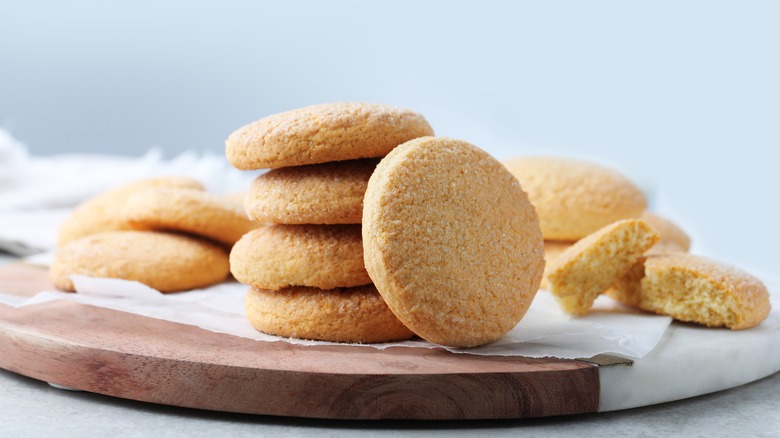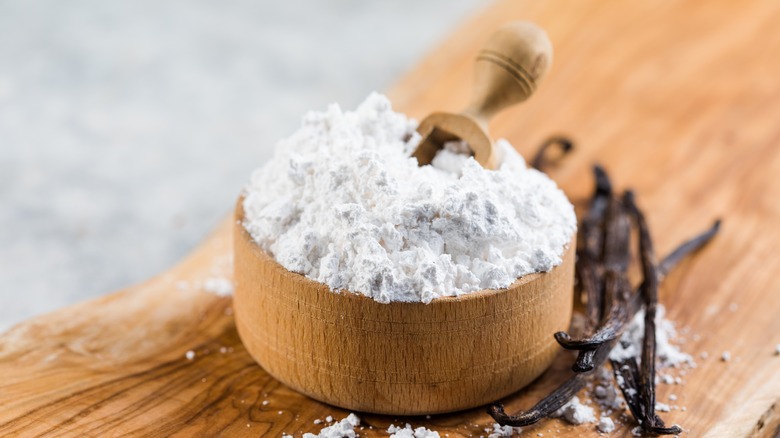Granulated Vs Powdered Sugar: Which Is Better For Sugar Cookies?
There's a vast world of sweeteners out there, and it seems like more options are cropping up on shelves all the time — from premium "raw" sugars to monk fruit, stevia, molasses, and so on and so on. But before the sugar aisle got so crowded, there were always the two primary options of granulated versus powdered sugar to choose from, and no baker's pantry would be complete without a bag of each.
Most of us are programmed to reach for granulated sugar in most baking situations — think when whipping up a batch of cookies or a birthday cake or even using sugar in savory settings like caramelizing onions. Typically, we reserve powdered sugar, or confectioners sugar as it's also called, for icings, foolproof whipped creams, or dusting on top of sweet treats.
At the end of the day, though, you can certainly use either option for a good batch of standard sugar cookies. Which one is best is not so much an objective answer but a matter of personal preference, desired texture, and flavor, and it may require a bit of sweet trial and error to find the perfect combo for you. The primary differences in the batch of cookies each sugar option will yield comes down to crunch and texture, but flavor is also affected in subtle ways depending on which you choose.
Granulated and powdered sugar yield two different textures
Both granulated sugar and powdered sugar start out the same — quite literally, as powdered sugar is simply granulated that's been finely pulverized until airy and light. Many of your store-bought bags of powdered sugar will also have a bit of added cornstarch, which acts to sop up any moisture and keep the bag from clumping up on the pantry shelf. The difference between powdered and granulated sugar is obvious to the touch and the naked eye — one is a fine, soft, almost weightless powder, while the other is a much coarser, grittier grain.
But to see how they interact with other ingredients in the heat of an oven, you'd have to zoom in with a magnifying glass. Powdered sugar, with its finely ground texture, clings to other ingredients like butter in a different manner than granulated does, and in baking cookie dough, it quickly spreads out and melts in less time than granulated sugar does. This quick melt time leaves cookies with a lighter, cakier, shortbread texture than you'd get from recipes using only granulated. On the other hand, the heftier grain of granulated sugar takes longer to melt and also creates more airy pockets when beaten with butter, resulting in a lighter, chewier, cookie with more crunch per bite.
Experiment with different ratios of each to find your perfect sugar cookie
Ultimately baking gets a reputation as something of a exact science, but that doesn't mean you can't have fun with experimentation in the kitchen. Because both sugars create a killer batch of cookies, there's no harm in doing a little A/B test of sorts, splitting your favorite sugar cookie recipe in half and making one portion with all granulated sugar and the other with all powdered. However, just like you wouldn't substitute brown sugar for white sugar 1:1 and expect no change to your baked good, expect a clear difference in how your two batches will come out of the oven.
Notice the differences in the texture, airiness, moisture levels, and taste, and determine which rendition is your cup of tea — there's no right or wrong answer. Just as some sweet treat lovers prefer cakey donuts and others go for fried every time, you may find one is a clear winner in your book. Don't want to choose favorites? Try a mix of half-powdered sugar and half-granulated sugar next time you get the baking itch for the best-of-both-worlds combo of soft, crumbly texture and moist crunchiness.


